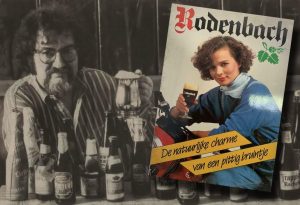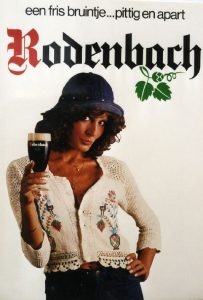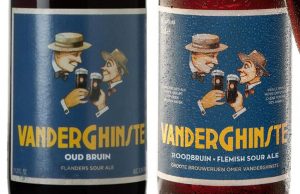Flemish brown, red or red brown? How Michael Jackson invented a beer style out of thin air
 Lately, I’ve been trying to make more sense of the history of the sour beers of Flanders, more specifically the ones found in today’s provinces of East and West Flanders.[1] These beers include well-known masterpieces of brewing, such as Rodenbach, Duchesse de Bourgogne, Liefmans Goudenband and others. Unfortunately, not a lot has been written about the history of these beers. For one thing, it’s very hard to find anything that resembles aged sour beers in Flanders prior to about 1850 (if you leave out the myth that somehow the Scheldt river is a Medieval boundary between the sour beers of Flanders and those of the rest of the country, which is utter fabricated nonsense).
Lately, I’ve been trying to make more sense of the history of the sour beers of Flanders, more specifically the ones found in today’s provinces of East and West Flanders.[1] These beers include well-known masterpieces of brewing, such as Rodenbach, Duchesse de Bourgogne, Liefmans Goudenband and others. Unfortunately, not a lot has been written about the history of these beers. For one thing, it’s very hard to find anything that resembles aged sour beers in Flanders prior to about 1850 (if you leave out the myth that somehow the Scheldt river is a Medieval boundary between the sour beers of Flanders and those of the rest of the country, which is utter fabricated nonsense).
Another complication is the distinction that is made between Flemish brown and Flemish red beer.[2] It’s a distinction I never really understood. Both ‘brown’ and ‘red’ beer are products of mixed fermentation involving lactobacillus and their tastes are very similar. Moreover, most of the beers that  today are grouped together as ‘Flemish red’ actually identify themselves as brown beers or have done so in the past. Rodenbach, viewed by many as the quintessential Flanders red, called itself a ‘fresh little brown’ on their labels until ca. 1990.[3] Ichtegems Oud Bruin still calls itself just that.
today are grouped together as ‘Flemish red’ actually identify themselves as brown beers or have done so in the past. Rodenbach, viewed by many as the quintessential Flanders red, called itself a ‘fresh little brown’ on their labels until ca. 1990.[3] Ichtegems Oud Bruin still calls itself just that.
Nowhere in traditional literature on Belgian beer is there even the slightest mention of a ‘red’ beer in Flanders or indeed anywhere in Belgium. So where does ‘Flanders red’ come from?
The answer lies in a monument of beer writing and beer culture in general: Michael Jackson’s 1977 World guide to beer. Jackson, a British journalist, was one of the first to chart all of the world’s beers for a consumers’ audience, thereby presenting the richness of what all the different countries had to offer. From the lagers of Czechoslovakia to the Bocks and Helles of Germany, from the pale ales and milk stouts of the United Kingdom to the Easter and Christmas beers of Denmark. One country in particular raised Jackson’s interest: Belgium.
Until then, Belgium had often been overlooked as a beer country. Until 1966, it had imported more beer than it exported. Belgians loved their trappists, spéciale belges and krieks, but outside their borders hardly anyone had ever heard of them. Jackson rightly praised Belgium for its diversity and for the unique taste of some of its traditional beers, like lambic.
One of the beers described by Jackson was Rodenbach from Roeselare. ‘This dark beer, known simply by its maker’s name, qualifies better for the epithet “red” than any of the copper-colored English brews which are sometimes similarly described in Continental Europe.’ For some reason, it seemed that Jackson was uncomfortable with the ‘brown’ denomination, which was common in Belgium at the time. Or he was just happy to ignore it.[4]
 In 1991, Jackson went down the same path. In The great beers of Belgium, he flatly split the beer style into two. There’s a chapter ‘Brown beers’ which describes the sour beers of Oudenaarde, notably Liefmans and Roman. And there’s a chapter ‘The “Red” beers of West Flanders’, which is mainly about Rodenbach. Jackson describes the difference as follows: the beers of West-Flanders ‘have a somewhat more reddish look and they have either a thinner, or a tighter “body”, and in any case a more pronounced sour mouthfeel (less lactic acid, more acetic acid)’.[5]
In 1991, Jackson went down the same path. In The great beers of Belgium, he flatly split the beer style into two. There’s a chapter ‘Brown beers’ which describes the sour beers of Oudenaarde, notably Liefmans and Roman. And there’s a chapter ‘The “Red” beers of West Flanders’, which is mainly about Rodenbach. Jackson describes the difference as follows: the beers of West-Flanders ‘have a somewhat more reddish look and they have either a thinner, or a tighter “body”, and in any case a more pronounced sour mouthfeel (less lactic acid, more acetic acid)’.[5]
Did Jackson invent a beer style out of thin air here? It sure looks like it. That would be a rather random way of handling beer styles. Ignoring local customs and denominations used by both the brewers and the drinkers, just because he feels it should be this way.
From there, the definition seems to have evolved towards ‘red beer is aged in wooden vats called foeders’, while brown beer is not, if for instance Wikipedia is anything to go by. That does not end the confusion however. The Oxford companion to beer phrases it like this: ‘The styles are often confused and some consider them to be one and the same. Stylistically speaking, however, Flemish brown does not show the “barnyard” Brettanomyces character often present in Flemish red, whereas Flemish red misses the deeper color and caramel nuttiness common in “Vlaams Bruin”.’[6] The Brewers Association’s Beer style guidelines however group the two together as ‘Belgian-Style Flanders Oud Bruin or Oud Red Ale’.[7]
 To complicate matters even more, a few Belgian brewers are now calling their beer ‘roodbruin’ (‘red brown’), notably a few from West Flanders: Rodenbach, Vander Ghinste, De Brabandere and Verhaeghe. Omer Vander Ghinste restyled its Bellegems Bruin as Vander Ghinste Oud Bruin in 2012, only to switch to Vander Ghinste Roodbruin (‘red brown’) in 2016.[8] De Brabandere recently did the same, their Petrus Oud Bruin is now Petrus Roodbruin. Note that none of these brewers call their sour beer flat out ‘red’: De Brabandere has a ‘Petrus red’, but it contains cherries (krieken).[9] In 2011, these four brewers applied for a Protected geographical indication (PGI) for their ‘Flemish red brown beer’. So far, such a European label has not been granted.[10]
To complicate matters even more, a few Belgian brewers are now calling their beer ‘roodbruin’ (‘red brown’), notably a few from West Flanders: Rodenbach, Vander Ghinste, De Brabandere and Verhaeghe. Omer Vander Ghinste restyled its Bellegems Bruin as Vander Ghinste Oud Bruin in 2012, only to switch to Vander Ghinste Roodbruin (‘red brown’) in 2016.[8] De Brabandere recently did the same, their Petrus Oud Bruin is now Petrus Roodbruin. Note that none of these brewers call their sour beer flat out ‘red’: De Brabandere has a ‘Petrus red’, but it contains cherries (krieken).[9] In 2011, these four brewers applied for a Protected geographical indication (PGI) for their ‘Flemish red brown beer’. So far, such a European label has not been granted.[10]
The confusion continues to this day: some people call all of these beers ‘brown’ beers, some call some of them ‘red’, some brewers think their beers are ‘red brown’. And historically, which basically means prior to 1991, they all were ‘brown’. In any case, to me the difference has always seemed artificial. Both the taste and production methods of these beers, from Rodenbach to Liefmans, are clearly very much related and all part of a dark-coloured family of Flemish sour beers. The question whether we really need a separate beer style called ‘Flemish red’ or ‘red brown’ remains open for debate.
[1] ‘Flanders’ originally was the name of a region that roughly comprises today’s provinces of East and West Flanders in Belgium, the region of French Flanders in France, and Zeeuws Flanders in the Netherlands. To complicate matters, ‘Flanders’ is now the name of the entire Dutch-speaking part of Belgium, which includes regions that previously were not part of Flanders: the provinces of Antwerp, Flemish Brabant and Limburg. For the remainder of this article, I will use ‘Flanders’ as a collective name for East and West Flanders.
[2] Also known as ‘Flanders red ale’ and ‘Flanders brown ale’. I avoid the denomination of ‘ale’ for Belgian beer. Until very recently, Belgians never referred to any of their beers as an ‘ale’, except for products that specifically were intended to resemble British ales. If today you can find Belgian beer that identifies itself as, say, ‘Trappist ale’ or ‘Flemish ale’, it is only to please Anglo-Saxon customers.
[3] Cf. http://jacquestrifin.be/bieres_brasserie_rodenbach1-78.php
[4] Michael Jackson, The world guide to beer, London 1977, p. 115. Thanks to Michael Weeks for providing me with the original English version. It seems that the Dutch translator was uneasy with Jackson simply calling it ‘red’, so the Dutch version contains phrases like ‘The Flemish brown that is red’ and ‘a wonderful dark colour, more red than brown’.
[5] Michael Jackson, De grote Belgische bieren, Antwerp 1991. This is my translation of the Dutch edition, as I don’t own an English-language copy.
[6] Garrett Oliver (ed.), The Oxford companion to beer, New York 2012, p. 631.
[7] https://s3-us-west-2.amazonaws.com/brewersassoc/wp-content/uploads/2020/03/BA-beer-style-guidelines-2020.pdf
[8] cf. http://www.worldbeerawards.com/winner/worlds-best-dark-beer-world-beer-awards-2015: at the World Beer Awards, it was still an ‘oud bruin’; the Internet Archive Wayback Machine has 2016 as the oldest date for the page on Roodbruin.
[9] https://www.brouwerijdebrabandere.be/nl/merken/petrus-sour-beers
[10] Het Nieuwsblad 30-4-2011; https://www.europarl.europa.eu/doceo/document/E-8-2016-003265_NL.html.






for me the main difference is that brewers in West-Flanders us STRAIGHT FOEDERS. In Oudenaarde beers are aged in normal vats/round foeders or just tanks.
The straight foeders have more contact with air on top and develop some acetic touch in a hot summer.
that make’s a difference in taste.
I think this is the relevant line from the English version of reference 4: “This dark beer, known simply by its maker’s name, qualifies better for the epithet “red” than any of the copper-colored English brews which are sometimes similarly described in Continental Europe.” Michael Jackson, The World Guide to Beer, p. 115.
[…] style categories are practically interchangeable: Flemish red ale (reliably exemplified by Rodenbach) and Oud Bruin (reliably exemplified by […]